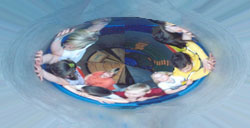Vlotinou P.1, Aggeloussis N.2, Vadikolias K.1 Giannakou E.2, Terzoudi Aik1., Piperidou X1., Heliopoulos I1.
1University Department of Neurology, General Hospital of Evros
2 Democritus University of Thrace, Department of Physical Education and Sport Science, Komotini,
nagelous@phyed.duth.gr
Abstract
The present study determines the changes in the spatial and temporal parameters of gait, in patients with dementia, under four conditions, the simple gait, the gait under a simple and complex kinetic goal and the gait under the influence of a cognitive target. 17 participants, diagnosed with Alzheimer’s dementia disease, (MMSE score:16-23/30) were evaluated and underwent gait analysis through a system of biomechanical analysis and a variance analysis for repeated measurements was applied for the statistical analysis. The results of gait analysis, showed that the gait speed as well as the frequency of the gait, showed significantly lower values when gait was performed under dual cognitive task, than in the other three conditions. On the other hand, stride length as well as step length, remained unaffected by the type of gait task. During dual cognitive task gait: pitch duration, duration of single and double leg support, were increased. The speed of walking and the frequency of walking, of dementia patients showed significantly lower values during walking with a double cognitive target relative to the other three conditions.
Download (pdf, 406kb)






